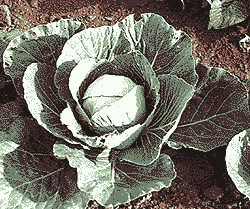|
from 25 august 2002 blue vol II, #47 |
|
|
 We will feature
in later editions recipes for Brocolli
(brassica oleracea italica), Brussels Sprout (brassica
oleracea gemmifera), Cauliflower (brassica oleracea
botrytis), Kale (brassica oleracea acephala), Kohrabi
(brassica caulorapa) and Turnip (brassica rapa). The
keen-eyed will notice that the Latin names indicate
they are from the same family. In fact they are all
descended from the same plant - the wild cabbage
(brassica oleracea), which is a native of temperate
climates. It took humanity only a few centuries, to
adapt and breed the wild cabbage into the varieties we
know today.
We will feature
in later editions recipes for Brocolli
(brassica oleracea italica), Brussels Sprout (brassica
oleracea gemmifera), Cauliflower (brassica oleracea
botrytis), Kale (brassica oleracea acephala), Kohrabi
(brassica caulorapa) and Turnip (brassica rapa). The
keen-eyed will notice that the Latin names indicate
they are from the same family. In fact they are all
descended from the same plant - the wild cabbage
(brassica oleracea), which is a native of temperate
climates. It took humanity only a few centuries, to
adapt and breed the wild cabbage into the varieties we
know today.
It is difficult for us in these modern times, when genetics has become an obsession for some scientists, to know why the ancients did this or when. It is likely it began in different places, which is why the wild cabbage has a family scattered around the world. Because it is a plant native to colder climates it is likely it was brought by nomads, and perhaps later by soldiers, to warmer climates, where the growing conditions were different. Sprouting Brocolli or Calabrese is the most nutritious of the cabbage family, producing calcium and iron as well as vitamins A, B and C. Not surprisingly, given the role of the Etruscans and Romans in modern agriculture, brocolli, as we know it, appears to be a native of Italy. Arguably this probably means it was brought to Italy by Roman centurions who took cuttings of wild cabbage and bred it, generation after generation for maybe a 100 seasons, to produce brocolli (or calabrese as it call is called in many countries). Did they realise, when the wild cabbage went quickly to seed in Italy's sub-tropical climate, that it was more nutritious and healthier for them? The Brassica family are rich in minerals, fibre, protein, carotene and vitamin C. This has been known to nutritionists for many a long year, but recently researchers learned they also contain compounds which attack cancerous cells. These compounds are known as glucosinolates. In brocolli a glucosinolate called glucoraphanin is found. When it is digested in its raw state in a salad for example it breaks down into an isothiocyanate called sulphoraphane, which can block cancerous cells. Ian Johnson and Gary Williamson, nutritional physiologists at the Institute of Food Research, Norwich, believe glucosinolates boost enzyme activity in the body's chemical detoxification system. Researchers at the Dutch Nutrition and Food Research Insitute in Zeist have come to the same conclusions. "The enhancement of such detoxifying systems could potentially increase the capacity to withstand the burden of toxicants and (pre)carcinogens we are exposed to daily." In brussels sprouts a glucosinolate called sinigrin is found. Sinigrin, which breaks down into a molecule called allyl isothiocyanate - responsible for the smell and taste of brussels sprouts - can knock out cancerous cells in the colon. But the effects of these compounds will be lessened if the brocolli or brussels sprouts are cooked to mush. So eat them raw in a salad. Of course northern Europeans have known about the benefits of cabbage for a very long time. The drumhead or white cabbage, which is closest to its wild cousin, has been the main ingredient in Sauerkraut, a fermented foodstuff known for its anti-scorbutic elements, and it would be remiss of us not to include the basic recipe. However, those with eco-political sensibilities may not want to associate themselves with a foodstuff that aided the colonialisation of hunter-gatherer peoples. It was sauerkraut that enabled James Cook to sail into southern hemisphere waters without his sailors succumbing to scurvy - which blighted most exploratory adventures well into the 19th century. When Cook set sail he made sure his supplies included barrels of fermented raw cabbage. At sea the daily diet included sauerkraut. Scurvy was avoided and the rest you know. Cabbage and red lentils
Dried lentils (puy, urid, chana or any small lentil), cup Given what we have just explained about eating raw cabbage it seems a little odd that we offer up this cooked meal of large green cabbage leaves and red lentils, but think about a raw cabbage (or sauerkraut) and garlic salad with cold cooked lentils dressed in sunflower oil for the summer when you are making this in winter. Pour enough fresh dried lentils into a mug or large cup and cook in three times the amount of water, until they are soft and mushy. Add a clove of crushed garlic, and set aside. Take about a dozen large cabbage leaves from the outside of a green plant, wash and trim off the stalks (keep to make a vegetable stock). Shake off the water, roll tightly and chop into thin strips. Add to the lentils and simmer gently until the cabbage is soft but still has some bite. This will serve one person.
|
|
BLUE is looking for short fiction, extracts of novels, poetry, lyrics,
polemics, opinions, eyewitness accounts, news, features, information and arts
in any form relating to eco cultural- social- spiritual issues, events and
activites (creative and political). Send to Newsdesk. |
